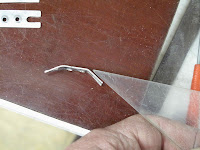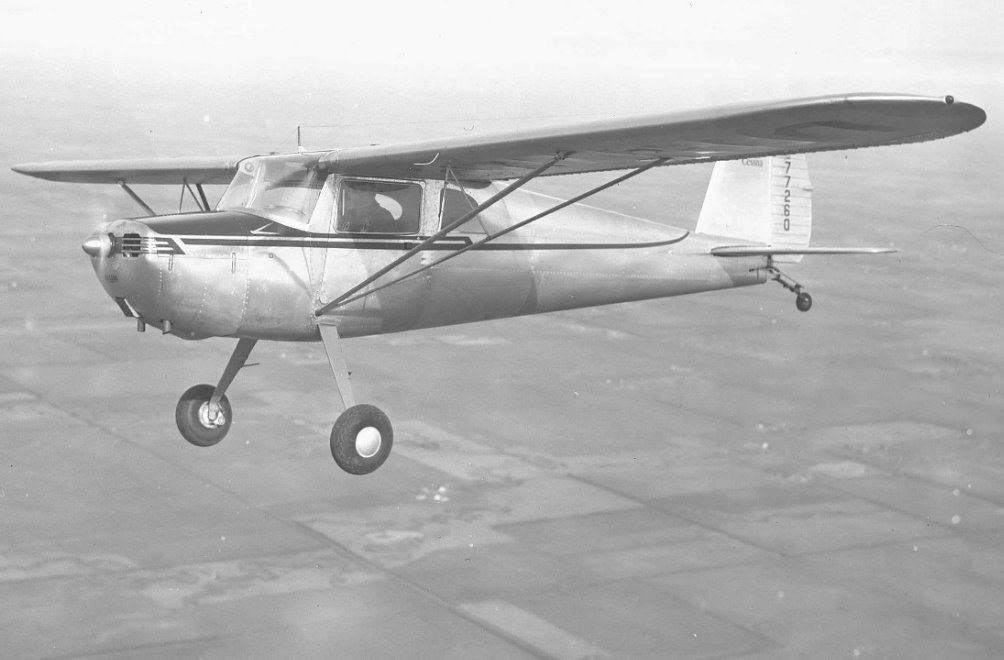The shock mounted portion of the instrument panel has a cover which makes it all look finished. It also covers the light bulbs so the light can reflect into the instruments. Unfortunately someone cut it up rather badly. It was designed to allow for adding cutouts for 2 1/4" instruments at each end of the panel. The holes for the optional instruments were in the structural part of the panel. One of the holes added was for a 3 1/8" instrument and the center was cut out probably for an artificial horizon. I just want minimal VFR instruments so I need either a new cover or repair this one. It probably would have been less work to form a new cover but I didn't have a piece of suitable aluminum so I decided to repair the old one.
To do this I'll make up pieces to plug the holes and backing plates to hold them in place with rivets. The first step was to trace the holes on a piece of aluminum.
After cutting each piece was filed and ground to as close a fit as possible. It doesn't have to be perfect as you can see from the light gaps with light shining through.
The small hole at the top is for the compass. The large instruments have an aluminum ring around the opening to finish the holes. The compass hole is just rolled over on the edge. I believe the two optional holes at the ends of the panel were finished in the same way.
To form this hole I made a form block from particle board, a clamping block to hold the metal flat while forming and a punch to form the bend. I rounded the edge of the hole in the form with a 1/8" radius router bit. The punch was made form a scrap piece of sledge hammer handle, from the OX-5 exhaust manifold project.
I clamped the form block with the aluminum piece sandwiched between it and the clamping block on top. I stood it up on the edge of a board so the hammer blows would be taken in the wood not the clamps.
The Punch was shaped fit in the hole in the backing block and a 45 degree chamfer ground on the edge. The wood flexed enough that I didn't need to match the radius on the form block. A couple good wacks with the 6 lb. sledge hammer did the trick.
The finished edge of the hole looks great.
All three plugs fit. It's starting to look like the cover again.
I started with the end backing plates because they were flat and easy to make. At first I thought I would need more space for riveting them in place but these are not structural parts. I trimmed the plates closer to the plugs, as you can see in a later picture. I punched the holes to attach the plug to the backing before punching the holes to attach it to the cover. This allows the plug to be fit in the holes to keep everything aligned while putting the holes in the cover.
The center panel needed flanges formed at the top and bottom to provide good places for the rivets. There was also a crack in the top flange which needed to be re-enforced. Everything was held in place with clecos until all the fitting was done.
Originally I planned to apply some epoxy in each joint to fill the gap with somethings which would bond well in the gaps between the cover and the plugs. I decided that was too messy. In the end I wish I had done it since no matter how carefully I filled and sanded you can still see a very light crack in the paint at the edges of the plugs. Hey I just want a good plane. If it bugs me later I 'll make up a new cover, but not until the plane is flying.
I primed everything before I started puttying and sanding.
The putty was built up and sanded in very thin layers. I wet sanded because it works better even though you need to let it dry well before you can do the next layer.
Before I paint I need to add the ring around the new tachometer hole. The factory glued the rings to the cover. They had some little tabs which they folded over to hold the ring tight. Once the glue dried they just ground the tabs off level with the ring. The ends of the tabs are still stuck in the glue. The ring at the right was added by whoever cut this up. I removed the ring and threw away the backing ring they added. To hold the ring in the tach hole I just used a stick of wood and a big rubber band. The stick applied the pressure to the front of the ring. The pencil was needed to keep the rubber band from touching the back of the ring. For glue I just used some 5 minute epoxy. It worked great.
The cover is held to the shock mounted panel with three clips (P/N 0412486) at the top and 2 screws at the bottom. The clips are riveted to the cover. They have tabs bent down with a slot for the panel to fit into. One clip was missing and the others have cracks in the corners of the slots so I need 3 new ones.
They're made from .032" aluminum 1 - 1/2" long by 7/16" wide. The slot is 1/8" wide and 5/16" deep.
The rivets were originally 3/32". The missing clip had 1/8" hole so It will just have to use large rivets.
I think the original clips cracked because because slot has square corners. All the cracks radiate from the corners. To help that I punched 1/8" holes at 5/16" and cut the slots tangent to the holes. We'll see in a few year if it helps.
The rivets are set flush so I had to dimple the rivet holes,
From the best clip it appears the tabs were bent at 30 degrees. That's the end of a 30 degree drafting triangle.
I used my sheet metal pliers, which I had put a nice radius on the edges. Just square them up and bend.
Rivet the tabs on and we're ready to paint.
I wanted a 2 tone paint job. I have this 1946 glove box door. In '46 they were on the left side. I'll use it on the right side. Since it's not in bad shape, I just polished the paint. The white lettering is now an Ivory color. The hardware store had Ivory paint and 6 colors of brown. I picked the closest brown and got on with it. I painted the rings Ivory and the cover brown. If I were doing this again I'd paint the rings with an air brush. The spray can was too hard to control well. To paint the Brown I propped up the cover so no painted edge would touch anything. I masked the rings to paint the brown. I think I could have done this more carefully but you have to look close to see where I goofed. After the paint dried I hung the cover in an over heated to 220 degrees and let it bake while the oven cooled. It added a nice shine to the paint.
The lower cover panels are painted with the Ivory. I like the vintage look.
Sunday, December 22, 2013
Subscribe to:
Posts (Atom)




































